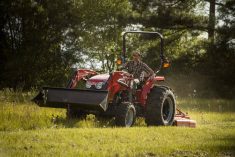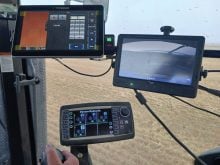Case IH’s new air seeder carts have jumped from the company’s previous 580 bushel capacity limit to a 950 bu. unit, with a 760 bu. stop along the way.
Size isn’t everything when it comes to seeder carts, but prairie farmers prefer fewer reloads and as a result, larger seeder capacities.
Joe Michaels, who heads the company’s specialty agriculture division, said producers have been looking for fewer and faster turn-around times when reloading and cleaning out their equipment, and that is what the company is giving them.
Read Also

Growing garlic by the thousands in Manitoba
Grower holds a planting party day every fall as a crowd gathers to help put 28,000 plants, and sometimes more, into theground
>>>>Sign up for our free daily morning email newsletter with the top news and markets information>>>>>
He said there are practical issues when it comes to “just making them bigger,” which are largely related to tending the machines and transportation on the road.
“We’ve looked at those issues. Making the carts quicker to load was key: faster turn-around and easier for the operator to manage,” he said.
“The new Five Series carts are a product of that thinking.”
Tank choices are two or three rotationally molded plastic tanks as primaries and a 25 or 35 bushel metal secondary tank on the 465 model and higher for canola, other small seeded crops and dry inoculants.
The cart models are named for the number of tanks the machine can have — two, three or four — and approximately how many bushels it will hold, rounded up to the nearest five.
The two biggest are tow behind only, while the rest can appear in either location.
Gord Engle of Case IH said the company sized the tanks based on producers’ typical seeding needs and then built the carts around that.
“The wagon-style steering is on here for the flotation and fewer issues in turning and headlands,” said Engle.
“We opted to go with the Mitas tires. They can be used in much lower pressures than many. With a 950 bu. capacity and high-flotation option, we got the pressure on the soil down to about 14 pounds per sq. inch. We are doing what we can to reduce that soil compaction at seeding, despite the size of the machine.”
Loading times have been reduced on a bushel per minute basis, said Engle.
The previous series of Case IH carts had an auger that could hit all the tank lids without repositioning the truck, and that remote control arm system has been retained. However, it now carsigned conveyor.
At 88 bu. per minute, even the largest cart can be filled in about 11 minutes, not including the time needed to move the truck or tender.
The auger is standard on the two largest units and optional on the 555 and 585 models.
Dan Klein of Case IH said the new 25 and 35 bu. tank are located between the bottoms of two larger hoppers, which required its own loading method.
A hopper mounted on a swing arm swings out from the right side of the machine and accepts a 50 lb. bag of seed or inoculant.
A venturi air lock system accepts the product, and a blower pushes the material up three pipes to the small tank.
“It is gentle and gets that loading off the top of the machine,” Klein said.
The small loader can be accessed from the ground, but the ideal method is from the back of a pick-up box. A mini-bulk bag or bulk seed tote can be lifted above the hopper for loading, with space away from the side of the seeder tanks.
The technology is similar to loaders found on some of the company’s Titan Floater fertilizer applicators.
The small tank is available on carts from 450 bu. and higher.
Tank lid openings have also become bigger on the 2016 models, and heavier ladders allow producers to enter the tanks more easily for cleaning and inspection.
The CNH metering system has been redesigned to allow producers to blend any product with any product and put any product they want in any tank without worrying about the metering system’s needs.
“Customers also have been asking for sectional control at the cart, and we have added that,” said Engle.
“We have done some calculations, and if you save 15 percent for the option, you can pay it off in a half a year’s seeding.”
The metering system is based on equipping each section with a 24 volt motor, which allows for variable rate on the new carts.
Material channeling doors allow a metering bank to be sent to any set of pipes headed for the drill.
This also lets producers change meter rate cartridges without clearing out the tanks.
There are three meter cartridges — a narrow, half and full width — and a standard meter roller.
“We know that farmers generally don’t forget to change them when they change products, but it can happen,” said Engle.
“And you can clear out a fertilizer lump or foreign material that gets into the tank without dropping everything out.”
The individual motors should also allow the company to add turn compensation in the future, which is important for larger drills in pothole areas.

















